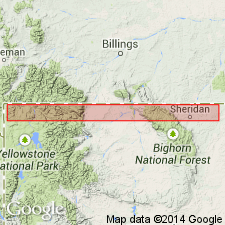
- Usage in publication:
-
- Moffat Trail Limestone Member*
- Modifications:
-
- Named
- Dominant lithology:
-
- Limestone
- AAPG geologic province:
-
- Yellowstone province
- Green River basin
Summary:
Named Moffat Trail Limestone Member of Amsden Formation, third member from base of Amsden for exposures measured on ridge north of Moffat Trail in NE1/4 sec 3, T33N, R117W, Lincoln Co, WY. Restricted to the mountain ranges (Salt River, Snake River, Hoback, and Teton) of western WY in western Sublette, Teton, and Lincoln Cos in the Yellowstone province and the Greater Green River basin. Eastern limit of the Moffat Trail thought to be near west margin of the Greater Green River basin. Isopach map. Consists of medium to coarse bioclastic calcarenite, brown, gray limestone, and has thin beds of pale-brown, silty dolomite and chert nodule zones. Is 65 ft thick at its type. Its thickest section is 110 ft in Salt River Range. Cross sections. Conformably overlies Horseshoe Shale Member and conformably underlies Ranchester Limestone Member, both of Amsden. Has middle and late Chesterian fossils (corals, foraminifers, bryozoans, ostracodes, gastropods, echinoderms, brachiopods). Deposited in a warm, shallow clear marine water.
Source: GNU records (USGS DDS-6; Denver GNULEX).
For more information, please contact Nancy Stamm, Geologic Names Committee Secretary.
Asterisk (*) indicates published by U.S. Geological Survey authors.
"No current usage" (†) implies that a name has been abandoned or has fallen into disuse. Former usage and, if known, replacement name given in parentheses ( ).
Slash (/) indicates name conflicts with nomenclatural guidelines (CSN, 1933; ACSN, 1961, 1970; NACSN, 1983, 2005, 2021). May be explained within brackets ([ ]).

